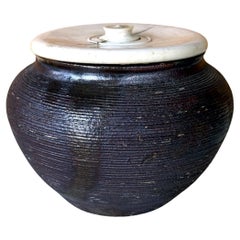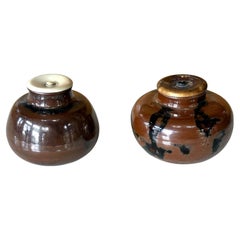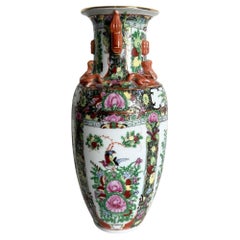Ceramic Scholar's Objects
to
29
62
12
89
1
1
1
1
19
25
45
5
6
17
1
1
3
2
13
1
165
165
90
89
44
65
64
33
16
14
89
89
89
3
1
1
Material: Ceramic
Furo Tea Ceremony Hibachi by Raku Kichizaemon xi Keinyu, 1817-1902
By Raku Kichizaemon XI Keinyu
Located in Prahran, Victoria
A furo tearoom brazier by Raku Kichizaemon XI Keinyu (1817-1902) decorated in bold style over a brick red glaze. The classical scene depicts men in ‘mino’ straw raincoats pulling a barge up river under the overhanging branches of an ancient willow tree.
With makers mark to base and sold with its original paulownia wood storage box.
Overall the piece is in excellent condition but has sustained several stress cracks in one corner due to heat encountered during continual use. This is typical of Japanese raku ceramics...
Category
Late 19th Century Japanese Meiji Antique Ceramic Scholar's Objects
Materials
Pottery
$1,950 Sale Price
25% Off
Blue And White Porcelain Calligraphy Brush Washer, Late Qing Period
Located in seoul, KR
In the late Qing Dynasty, it was popular to incorporate calligraphy and poetry into ceramics. The piece has a flat, oval shape and was likely used as an inkstone, one of the essentia...
Category
20th Century East Asian Qing Ceramic Scholar's Objects
Materials
Ceramic
Antique Japanese Ceramic Tanba Chaire with Lid
Located in Atlanta, GA
A stoneware ceramic chaires (Tea caddies) of Ko-seto ware type from Edo period Japan circa 18th century. This type of small jar was made of stoneware possibly in Tanba (Tamba) kilns,...
Category
18th Century Japanese Edo Antique Ceramic Scholar's Objects
Materials
Ceramic
Set of Two Antique Japanese Ceramic Ko-Seto Chaires
Located in Atlanta, GA
A collection of two ceramic chaires (Tea caddies) of Ko-seto ware type from Edo period Japan circa 18th to early 19th century. This type of small jar was made of stoneware in old Set...
Category
18th Century Japanese Edo Antique Ceramic Scholar's Objects
Materials
Ceramic
Chinese Hand Painted Multi Colored Vase
Located in Delray Beach, FL
Add a vibrant touch of artistry to your space with this Chinese hand-painted multi-colored vase. Featuring intricate patterns and a stunning array of col...
Category
Mid-20th Century Chinese Ceramic Scholar's Objects
Materials
Porcelain
$156 Sale Price
20% Off
Korean Ceramic Water Dropper in Dog Form Joseon Dynasty
Located in Atlanta, GA
A lovely Korean ceramic water dropper in the form of a sitting dog circa 19th century late Joseon Dynasty. The charming animal form features underglaze blue paint outlining the furs ...
Category
19th Century Korean Antique Ceramic Scholar's Objects
Materials
Ceramic
Boho Chic Green & Orange Floral Glazed Clay Floor Vase
Located in Delray Beach, FL
Amazing vintage boho chic glazed clay floor vase. Features a etched exterior with a green orange and blue finish.
Category
1990s Ceramic Scholar's Objects
Materials
Clay
$396 Sale Price
20% Off
Korean White Ceramic Stem Dish Joseon Dynasty
Located in Atlanta, GA
A ceramic dish with high cylindrical foot in white glaze from Korea, circa 19th century Joseon Dynasty. By shape, this piece is most likely a ceremonial vessel that was used to make offerings on the altar. Although without inscription, we can't rule out that it could be a household item for occasions that were less formal. Such as a private shrine in the household. During Joseon dynasty, the social morals were largely centered on the principles of Confucianism that originated from China. Many ritual ceramic wares were produced for rituals and worships on all level of the society. The ware were often modeled after the archaic bronze ware that elevated them from the aesthetic of daily use pieces. High foot dish like this were made in both round and square shape to suite different use but they were all distinguished with the inscription for their exclusive ceremonial purpose.
Of elegant form and harmonious proportion, this stem dish...
Category
19th Century Korean Archaistic Antique Ceramic Scholar's Objects
Materials
Ceramic
Korean Ceramic Ritual Offering Vessel with Inscription Joseon Dynasty
Located in Atlanta, GA
A ceramic dish with high cylindrical foot in white glaze with a cobalt blue underglaze inscription from Korea, circa 18-19th century Joseon Dynasty. This is a classic ceremonial vess...
Category
Late 18th Century Korean Archaistic Antique Ceramic Scholar's Objects
Materials
Ceramic
$3,200 Sale Price
46% Off
Postmodern Red Ceramic Vase by Haeger
Located in Delray Beach, FL
The Haeger Red Postmodern Vase is a stunning piece that effortlessly blends art and function, capturing the essence of postmodern design with its vibrant red hue and unconventional f...
Category
20th Century American Post-Modern Ceramic Scholar's Objects
Materials
Ceramic
Postmodern People Brushed Ceramic Floor Vase
Located in Delray Beach, FL
Exceptional vintage postmodern ribbed ceramic floor vase. Features a beige finish with a purple brushed accent.
Category
1980s American Vintage Ceramic Scholar's Objects
Materials
Ceramic
$476 Sale Price
20% Off
Chinese Qing Dynasty Porcelain Spotted Deer Brush Washer, Mid-19th Century
Located in Austin, TX
A charming and elegant Chinese brush washer in the form of a recumbent spotted deer, Qing dynasty, circa 1850.
The graceful animal modeled with ...
Category
Mid-19th Century Chinese Qing Antique Ceramic Scholar's Objects
Materials
Porcelain
Postmodern Light Green Scalloped Ceramic Vase
Located in Delray Beach, FL
Incredible vintage postmodern ceramic vase. Features a gloss might green finish with a scalloped shape.
Category
1980s American Post-Modern Vintage Ceramic Scholar's Objects
Materials
Ceramic
$236 Sale Price
20% Off
Vintage Hand Made Pottery Jars With Lids - 2 Pieces
Located in Delray Beach, FL
This set of two vintage handmade pottery jars showcases artisan craftsmanship with earthy tones and rustic charm. Each jar comes with a lid, perfect for storing small items while add...
Category
1970s American Vintage Ceramic Scholar's Objects
Materials
Pottery
$156 Sale Price
20% Off
Postmodern Hand Painted and Carved Large Floor Vase
Located in Delray Beach, FL
Elevate your space with the Postmodern Hand Painted and Carved Large Floor Vase, a true artistic statement piece. This vase showcases bold colors and abstract designs typical of the ...
Category
20th Century American Post-Modern Ceramic Scholar's Objects
Materials
Ceramic
Postmodern Pink Ceramic Floral Vase
Located in Delray Beach, FL
Exceptional vintage Postmodern ceramic floor vase. Features a glossy pink finish with flowers etched around the bust and base.
Category
1980s American Post-Modern Vintage Ceramic Scholar's Objects
Materials
Ceramic
$396 Sale Price
20% Off
Korean Ceramic Ritual Offering Stemmed Dish with Inscription Joseon Dynasty
Located in Atlanta, GA
A small ceramic stemmed dish with high cylindrical foot in white glaze with a cobalt blue underglaze inscription in the center from Korea, circa 18-19th cent...
Category
Late 18th Century Korean Archaistic Antique Ceramic Scholar's Objects
Materials
Ceramic
Chinese copper red porcelain ink box, 19th c.
Located in New York, NY
gold floral motif on copper red ground
Category
Late 19th Century Chinese Antique Ceramic Scholar's Objects
Materials
Porcelain
Vintage Erven Lucas Amsterdam 1 Liter Clay Bottle
Located in Delray Beach, FL
Exceptional clay bottle from Amsterdam by Erven Lucas. Features a browned clay tone with its capacity, maker and place of origin carved into the sides. 1 liter
Category
1960s Dutch Vintage Ceramic Scholar's Objects
Materials
Clay
1980s Hand Painted Southwest Pottery Case
Located in Delray Beach, FL
Dive into the artistry of the 1980s with this Southwest Pottery Vase. Hand-painted in a vibrant green hue, it showcases a lone wolf set against a moo...
Category
20th Century American American Classical Ceramic Scholar's Objects
Materials
Pottery
Mid Century Modern Brown Spherical Danish Pottery Vase
Located in Delray Beach, FL
Incredible mid Century Modern danish pottery vase. Features a brown and gold coated finish.
Category
1960s Danish Mid-Century Modern Vintage Ceramic Scholar's Objects
Materials
Pottery
$1,356 Sale Price
20% Off
Postmodern Circular Cream Vase by Haeger
Located in Delray Beach, FL
Introducing the Postmodern Circular Cream Vase by Haeger, an elegant piece that doubles as both a functional vase and a standalone sculpture. Its balanced, circular design and cream ...
Category
20th Century American Post-Modern Ceramic Scholar's Objects
Materials
Ceramic
$316 Sale Price
20% Off
Postmodern Black, Blue and Purple Paper Mache Vase
Located in Delray Beach, FL
Exceptional postmodern floor vase. Features a black finish with a blue and purple paper mache around the side.
Category
1980s American Post-Modern Vintage Ceramic Scholar's Objects
Materials
Ceramic, Paper
$316 Sale Price
20% Off
Korean Ceramic Water Dropper in Mountain Form Joseon Dynasty
Located in Atlanta, GA
A Korean ceramic water dropper in the shape of a mountain from late Joseon Dynasty circa 1850-1900s. The lovely piece takes a shape of a rugged mountain peak with crags and furrows, ...
Category
Late 19th Century Korean Other Antique Ceramic Scholar's Objects
Materials
Ceramic
Italian Postmodern Cream With Colored Streak Vase
Located in Delray Beach, FL
Wonderful vintage postmodern ceramic vase made in Italy. Features a cream glossy finish with purple, blue pink streaking around the surface.
Category
1980s Italian Post-Modern Vintage Ceramic Scholar's Objects
Materials
Ceramic
$316 Sale Price
20% Off
Postmodern Black Gloss Vase by Haeger
Located in Delray Beach, FL
Immerse in the allure of postmodern design with this Black Gloss Vase by Haeger. With its captivating gloss finish and angular form, this vase is more than just a container—it's a ...
Category
20th Century American Post-Modern Ceramic Scholar's Objects
Materials
Ceramic
$316 Sale Price
20% Off
Inkwell with seated Buddha figure, France, 19th century
Located in London, GB
The object depicts a Buddha sitting on a decorative base, holding a small red object. The Buddha figure is rendered with a smiling, serene expression typical of traditional iconograp...
Category
19th Century Antique Ceramic Scholar's Objects
Materials
Bronze
Korean Ceramic Water Dropper in Frog Form
Located in Atlanta, GA
A Korean ceramic water dropper in the form of fog circa early 20th century likely from Japanese colonial time post 1910s. The animal form features under...
Category
Early 20th Century Ceramic Scholar's Objects
Materials
Ceramic
Vintage Pottery Vase by Gail Markiewicz
Located in Delray Beach, FL
Add an artisanal touch to your space with this vintage pottery vase by Gail Markiewicz. Featuring organic textures and a unique, handcrafted design, this vase brings a sense of natur...
Category
1980s American Vintage Ceramic Scholar's Objects
Materials
Pottery
$396 Sale Price
20% Off
Recently Viewed
View AllMore Ways To Browse
Bamboo Brush Pot
Chinese Zitan
Rock Display Stand
Suiseki Stones
Chinese Brush Stand
Jade Archer
Jade Handle
Chinese Ink Stone
Jade Archer Ring
Snuff Bottle Stopper
Antique Chinese Carved Bamboo Brush Pot
Chinese Brush Holder
Asian Green Marble
Carved Jade Bonsai Tree
Chinese Calligraphy Brush And Stand
Chinese Jade Brush
Chinese Scholar Seal
Carved Calligraphy Brush





